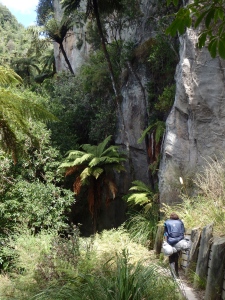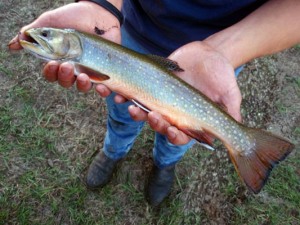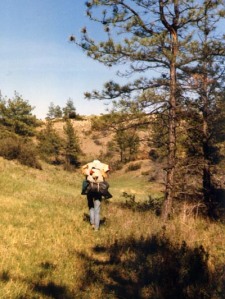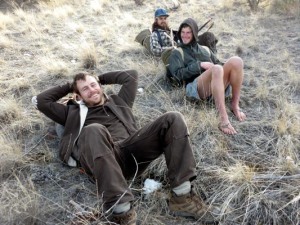The Green Post Campaign to Reclaim Everyman’s Right to Roam
America is often called the “land of the free,” yet we are not free. Citizens are not confined, but rather restricted by an endless barrage of “No Trespassing” and “Keep Out” signs across the country. We think of this existence as normal, so normal that we rarely think about it at all. Yet, the proliferation of No Trespassing signs is a cultural aberration that is relatively recent, at least in some parts of our country, and very much at odds with traditions in other parts of the world. Moreover, posting property to keep people out fosters idleness and thus boredom, which can lead to vandalism and abuse that makes No Trespassing signs appear necessary in the first place. If we wish to raise a populace that is fit, healthy, responsible, and free, then we must cross-examine the idea of private property and compare our cultural expectations with those of people from other lands.

New Zealand is crisscrossed with such an amazing abundance of public walking tracks that there is little incentive or need to trespass.
I found it refreshing to travel in New Zealand for five weeks, where I did not encounter a single No Trespassing or Keep Out sign anywhere in the country. The most stringent sign I saw was a “Multiple Hazard” warning, cautioning people about entering farmlands. On the other hand, the country also has an amazing system of trails or “tracks,” as they call them. These tracks are easily accessible trails, providing little incentive for anyone to trespass. In visiting with the locals, I learned that New Zealand laws and customs are both very access-friendly. For example, most beaches and watercourses are considered public property. I enjoyed walking one public track along the waterfront near the town of Paihia, along the Bay of Islands. Private properties along the trail were sometimes brushy and fenced off, or might have a house right along the track with no fence, or sometimes the trail would even wind across a property and around a tool shed. The track always took precedence, and as long as people have the ability to walk unimpeded, what need is there to trespass?

Public tracks in New Zealand often cross working farms and ranches. In this case, the trail went across a cattle pasture and through a unique gate.
Watercourses, I was told, include any little perennial or intermittent stream going across any pasture or down a hill, with access along either side to the width of the “Queen’s chain,” or about sixty-six feet. In addition, New Zealand has an extensive network of “paper roads” across otherwise private property. These public right-of-ways were defined when the land was settled and surveyed, and they remain legally open to public use, even if roads were never built.
Perhaps most importantly, it is culturally acceptable in New Zealand for people to cross private property, although it is considered polite to ask when crossing private property near a farmhouse. Equally important, it is culturally unacceptable to lock people out. One local mentioned a neighbor who migrated to New Zealand from Pennsylvania and bought a large farm. The newcomers couldn’t legally close the public track across their land, but in order to discourage anyone from using it, they let the trail grow so thick with brush and tall grass that nobody wanted to go there anymore. The locals frown at the inhospitality of these American transplants!

Land along small streams are public right-of-ways in New Zealand. This walking track follows a stream across a farm.
The idea that people should have freedom to roam is not unique to New Zealand. It is also a long-standing tradition in Scandinavian countries, known as allemansrätten in Swedish or “the everyman’s right.” These centuries-old traditions have been coded into law in recent decades. In Norway, Sweden, and Finland, people have the right to hike, ski, camp, and forage for wild food on undeveloped private properties, provided they respect landowners and don’t harm the environment. Bicycling is also allowed where appropriate. While the public is not allowed to enter cultivated lands during the growing season or pastures when livestock are present, other times of the year are okay. Somewhat similar customs and laws are found in Estonia, Latvia, Lithuania, Austria, Switzerland, Belarus, and the Czech Republic.

As a teenager I built a grass hut among the trees at the edge of a farm field near town, nurturing a healthy connection with nature.
Scotland also has a longstanding tradition of public access to private lands, which was formally recognized in law with Scotland’s Land Reform Act of 2003. Citizens are allowed to walk, bicycle, ride horseback, and camp on private lands, provided they don’t damage the environment or interfere with farming or other private-land uses. England and Wales recently expanded public access with the Countryside and Rights of Way Act 2000, granting freedom to roam the open countryside.
In my home state of Montana, the freedom to roam has been a custom, tradition, and presumed right since the days of the frontier. As a teenager in the 1980s, I lived in Bozeman and walked nearby farm fields regularly, where I tracked everything from foxes to skunks in snow-covered fields. In a tangle of brush along an irrigation ditch, I built a hut of sticks and grass thatching, deepening my connection with nature. During weekends and summers, I went to my grandmother’s house in the country, where I walked for miles in every direction, crossing livestock fences all the way.
No Trespassing signs are a recent phenomenon, largely introduced by newcomers who, oblivious to Montana’s tradition of openness, imported their cultural expectations with them. Orange paint on a fence post signifies the same thing as a No Trespassing sign, so we have gained a few signs and a lot of orange paint, while losing access to millions of acres of land. Sadly, there wasn’t a public debate about it, because our cultural values were not recorded or publicized, and the loss occurred slowly, property by property across the state. People were unaware that by posting No Trespassing signs, they were not only closing down access to their own land, but also encouraging their neighbors to do the same, such that everyone lost access, including themselves. Unfortunately, “the everyman’s right” to roam was never formalized into law, nor was it written down as a guidebook for new residents.
The cultural shift can be shocking to someone who experiences it for the first time. For example, one local rancher sold his property and retired. He was always pleased to see people out fishing the streams on his property, so he was alarmed and saddened to see that the new owners posted the property, and even he was not allowed to go back and walk the land he had called home for decades.

Montana landowners traditionally welcomed hikers and fisherman on their land. No Trespassing signs were largely introduced by newcomers to the state.
The Journey
In 1804 through 1806, Lewis and Clark led the Corps of Discovery on an expedition up the Missouri River, over the Rocky Mountains, and down the Columbia, in search of a navigable route to the Pacific Ocean. They may not have found the Northwest Passage they had hoped for, but their journey of discovery led the nation westward and continues to inspire people today.
Similarly, individual journeys of discovery can be very powerful experiences that deeply shape a person’s life. For example, after the devastating loss of her mother and her marriage, Cheryl Strayed rebooted her life alone on the trail, as told in her best-selling book Wild: From Lost to Found on the Pacific Crest Trail. Her story was retold as a Hollywood movie played by Reese Witherspoon. Having the freedom to engage in a journey such as this is a basic need and fundamental human right, “the everyman’s right,” that should be easily accessible to all people, especially young adults who are searching for their path in life. Every person should have the opportunity to walk or paddle and camp to the horizon and beyond in their own journey of discovery.

A friend and I walked 500 miles across Montana in 1988, about half of which was across private lands.
I have undertaken several such journeys myself. In 1988, at the age of twenty, a friend and I walked five hundred miles across Montana, starting at my grandmother’s house in Pony and ending at Fort Union on the North Dakota border. We crossed private property for nearly half the trip, and rarely encountered landowners, but had largely positive encounters with those we met.
Our route took us to one of Ted Turner’s ranches, where we encountered a gate plastered with about twenty No Trespassing and Keep Out signs. Unfortunately, there was literally no other route available to us, so over the gate we went. The property manager wasn’t particularly enthusiastic to see us, but he allowed us to camp and move on. The next big ranch was also posted, but they invited us to join them for a nice hamburger dinner. Most people we met were supportive of our adventure. A few were mildly disgruntled and suggested that we should be responsible and get a job, but waved us onward. Journeys such as this have been greatly empowering, giving me the confidence and determination to follow my dreams in life.
The consequences of posting property runs much deeper than may be readily apparent. Locking people out can cultivate resentment and encourage rebellion and abuse. On the other hand, giving people expanded freedom to roam can foster a greater sense of stewardship and gratitude, which ultimately reduces vandalism and litter.

Having the freedom to roam across the countryside can help foster a greater sense of gratitude and stewardship.
In our Green University, LLC internship program (www.GreenUniversity.com), we sometimes have students who act as if the property boundary is a cage, even when there are ample public lands nearby. They come from a culture where they feel confined to boxes, and it doesn’t occur to them that they are free to wander. They frequently feel trapped by society, that they are not free to live their own dreams. They are often so conditioned to being in a box that it never occurs to them to walk past the property boundary to walk the 100,000 acres of public lands in the Tobacco Root Mountains, just outside my door. I’ve met young people who are angry at society, angry at the machine of civilization, angry at the way the system enslaves and dehumanizes people. They are so accustomed to the experience of being trapped that they don’t recognize freedom even when the door is open and they can go anywhere they want. Other people may not feel the same depth of malcontent or they may not verbalize it the same, but the sense of confinement underpins some of the biggest issues we face as a society, from alcoholism to drug abuse, obesity, and a simmering cauldron of civil unrest that threatens to undermine our country.
While touring New Zealand, I appreciated the fact that litter was relatively scarce compared to the states. Yet there was some litter, and I wondered how much of it was dropped by American tourists who have lost a sense of connection and stewardship of the land. It also occurred to me that No Trespassing signs are in themselves a form of litter, an eyesore on the landscape. It was refreshing to travel in a place that wasn’t marred by glaring signs tacked to the fence posts.
Expanding Public Access
The logical citizen response to the rise of No Trespassing signs is to work for better access to public lands, which is essential, yet an inadequate step to meet the level of need. Here in Montana, we are blessed with large tracts of public lands, comprising nearly 30 percent of the total area of the state, and land managers have worked to secure formal public access to tracts that didn’t previously connect to public right-of-ways.
Ironically, public lands without public access can be lost not only to the public, but also to the private landowners that block access. For example, Beall Creek in the Tobacco Root Mountains has no formal public access, and as a result a wonderful forest trail has fallen into such disrepair that the watershed is largely unusable even to the people who live right there.

Montana retains a friendly trespass law, which states that a person is allowed to enter private property as long as it isn’t posted at any obvious entry points and the landowner hasn’t verbally or otherwise stated that the visitor is unwelcome.
Fortunately, Montana retains a friendly trespass law, which states that a person is allowed to enter private property as long as it isn’t posted at any obvious entry points and the landowner hasn’t verbally or otherwise stated that the visitor is unwelcome. Any rural property that is not posted is theoretically open to public access, although it is always polite to ask first.
Montana also has some of the best stream access laws in the state, which have been codified in law and protected by the courts, thanks to the tireless efforts of advocacy groups, such as the Public Land/Water Access Association, Inc.. PLWA has successfully stopped numerous attempts by out-of-state landowners and their attorneys to claim the land for themselves and lock the public out. In some states the rivers are considered public, but the land underneath is not, such that a person is technically trespassing if they step out of a boat. But in Montana, anglers can float down a river and get out to fish or camp anywhere “within the ordinary high water mark,” provided that their camp is not too close to a neighboring home.
On the other hand, Montana is far behind other states in rails-to-trails opportunities. Other states have been proactive with legislation claiming abandoned railroads as public rail trails, but Montana has done nothing, letting the easements on most old railroad beds fall to private landowners, losing hundreds of miles of potential rail trails across the state. Advocacy groups are working to reclaim abandoned rails across public lands for trails, but railroad beds on private lands rarely become public again.
As an avid hiker, I’ve always spent my summers exploring public lands in the mountains, but when winter comes and the mountains are deep with snow, I forgo the winter boots and keep my regular shoes to hike across thousands of acres of low-elevation private lands, principally along the Jefferson River. I’ve come to know a lot of special places along the river, and I’ve been alarmed to see development and No Trespassing signs chip away at the integrity of the Jefferson.

Hiking and camping on private lands along the Jefferson River led to concern over subdivision, development, and “No Trespassing” signs on the river. It ultimately inpired me to found the Jefferson River Canoe Trail to help sustain the Montana traditions of open space and open access.
These experiences led to the founding of the Jefferson River Canoe Trail (www.JeffersonRiver.org) and our group efforts to secure quality public campsites and to encourage conservation easements along the river corridor. Water trails are especially valuable because they cut through private lands, allowing ordinary people to have their own personal journey of discovery.
As part of the effort to replace lost access, our state passed legislation allowing public use of state lands that are leased out to farmers and ranchers, provided there is legal access to those properties. The state’s Department of Fish, Wildlife, and Parks has also set up a block management program where landowners are paid a small supplement to keep their properties open to hunters. Strangely, it is considered trespassing to cross from one public property to another where the fences meet only at the corners. Even if the hiker or hunter doesn’t set foot down on the private land to either side, some private property owners somehow feel violated and have thus far killed legislative attempts to legalize corner crossings, but hopefully that will change in the near future.
These multi-faceted efforts to maintain or restore access definitely help, and Montana is already a leader in providing public access, yet we can do so much more to benefit Montanans and to provide a positive role model for other states to follow. What is needed most is a re-evaluation of our cultural expectations.
Reclaiming Our Heritage
The nonprofit Western Sustainability Exchange published a Welcome to the West guide to educate newcomers to Montana about key issues that many people don’t otherwise consider. For example, people often see a beautiful site and decide to build a house in the middle of it, not realizing that they are damaging exactly the asset they valued. All newcomers to the state should be provided with this Welcome to the West guide, and a section should be added to educate newcomers about the Montana tradition of open space and open access. We also need a statewide educational campaign to encourage landowners to paint their fence posts green to welcome healthy trespassing.
In addition, we need to reconnect our young people to the land to ensure that they will honor and respect both private and public property. One way to do that is to encourage partnerships between public schools and Fish, Wildlife, and Parks, such that every school adopts, monitors, and helps manage and maintain state parks and local fishing access sites. FWP can benefit from student labor to help repair damaged picnic tables, fire rings, outhouses, or other facilities, as well as help with weed control, picking up litter, and collecting data on vegetation and wildlife populations. The students can benefit from the experiential real-world opportunities while developing a sense of ownership and stewardship that will carry forward whenever they visit other sites around the state.
We can also expand the Montana Conservation Corps (MCC), encouraging young people to do a year of service between high school and college, working with the MCC to build and maintain trails, again cultivating an ethic of stewardship and a love for the outdoors that will stay with them for life.
In Montana and across our nation, outdoor recreational opportunities are essential to the wellbeing and quality of life of the people. In lieu of a codified “everyman’s right,” we need to expand water trails and rail trails, and facilitate access to existing public lands. Just as importantly, we need to initiate a dialogue about the longstanding tradition of public access to private lands and bring awareness and desire to reclaim our essential heritage to freely roam the open countryside.

Thomas J. Elpel is the founder of Outdoor Wilderness Living School (OWLS) in Pony, Montana.
Thomas J. Elpel is the author of numerous books and videos about sustainable living and reconnecting with nature. He is the founder and director of Outdoor Wilderness Living School, LLC (OWLS), dedicated to reconnecting children and nature. For adults, he founded Green University® LLC to “connect the dots from wilderness survival to sustainable living skills.” Elpel also founded HOPS Press, LLC and the Jefferson River Canoe Trail.

Check out:
Participating in Nature: Wilderness Survival and Primitive Living Skills





 Thomas J. Elpel Personal Website
Thomas J. Elpel Personal Website
This is great! New Zealand sounds wonderful. I’ve often noticed that in florida where I live, one can barely take a walk out the front door before they encounter some type of barrier to taking a stroll. I couldn’t help but reminded of Thoreau’s essay “Walking” in which he made some of the same points even back in his day. Thank you. Great article.
Reminds me of your quote about “access to nature being both immense and imaginary”. In this case, trail access can be very real.
Now it seems the opposite of posting “no trespassing” signs is necessary, in some communities we now need to post educational signs to let people know that they can in fact can access the trail legally.
The Public Land and Water Access Association goes beyond just talking
about preserving and enhancing Access to public land and water. We go to court to ensure it is protected. If there are any other organizations or agencies in the state that are doing this i am not aware of them. As of today PLWA is involved in three major lawsuits and using several other tactics designed to protect our access opportunities. As President of PLWA I encourage your readers to visit our web site plwa.org.
John Gibson
Federal agencies no longer have objectives to provide access to public lands, nor challenge access to public lands being closed. In Montana the PLWA organization has advocated, fought for and defended access to public lands and rivers. If it were not for PLWA we may have lost the Montana stream Access law. The Montana legislature has passed stricter trespass laws and has blocked public access bills like the corner crossing bill that would have provided access to 80,000 acres of public lands, not accessible to the public. If you support access to public lands, rivers and streams join PLWA. Help them keep fighting for public access.
Ray Gross
That’s a sensible answer to a chenlanging question
The concept of “usufruct” has been around since Roman times, whereas you can use otherwise private property as long as you leave enough for the owner to do his business. Many mourn the tragedy of the commons which indeed does shine a light on the hazards of unrestricted use by all, but there must be a commonality for all residents. In Scandinavian countries, you literally are allowed to camp in someone’s “back yard”!!I grew up walking out the back door of my grandfather’s house with the dogs and a shotgun and not stopping anywhere for a posted sign…. AND the only way to deny access was to put up signs every 50 yards. I’m not certain of the origin of the militant attitude “I’ll shoot you, you’re trespassing!!” mentality but suspect it is cultured in the paranoia-induced rhetoric from Ag orgs like Farm Bureau Federation and MT Stockgrowers who regularly resist any attempts to enhance public access like a corner crossing bill. (Why would someone be insulted if your elbows cross their “private property” at the corners??? Doesn’t make sense.) I do argue with Mr. Elpel; it isn’t simply outsiders. Homegrown Montanans are getting worse every day. In a day of fishing, while wading and fishing, I actually got in a fist fight with the landowner while fishing through his 75 yds. of ground. I am happy to see the common gorund of access being cultured. Yup, been involved with PLWA for years and they’re almost the only game in town at times, although it’s difficult to draw a line between their work and the work of the local Rod&Gun Clubs and MT Wildlife Federation. Support their efforts financially, it is worth it!
I am a firm believer that ALL conservation easements must include access as part of that easement. After all, the tax consequences that are the basis of every conservation easement, are granted at the expense of every other taxpayer … the public. The public that, without access, may be getting nothing for its forgone tax dollar.